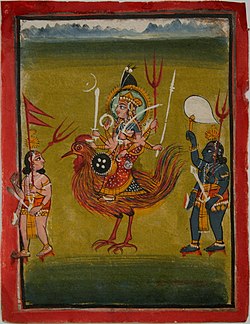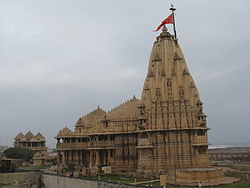Becharaji
Becharaji | |
|---|---|
Town | |
 Bahuchara Mata Temple complex in 2018 | |
| Coordinates: 23°29′53″N 72°02′35″E / 23.498°N 72.043°ECoordinates: 23°29′53″N 72°02′35″E / 23.498°N 72.043°E | |
| Country | |
| State | Gujarat |
| District | Mehsana |
| Population (2011) | |
| • Total | 12,574 |
| Languages | |
| • Official | Gujarati, Hindi |
| Time zone | UTC+5:30 (IST) |
| PIN | 384213 |
| Vehicle registration | GJ-02 |
| Sex ratio | 952 ♂/♀ |
Becharaji or Bahucharaji is a Hindu temple town and taluka capital in Mehsana district of Gujarat state, India. The temple of Hindu goddess Bahuchara Mata in the town is major pilgrimage centre.
History[edit | edit source]
The name of the town is derived from Bahuchar Mata or Bahucharaji, a Hindu goddess. The region around the town is known as Chunwal. The Bechar village is located 1 km south of the temple while Sankhalpur village is located 2 km north of the temple. The modern town developed around the temple between these two villages.[1]
The ruler Sayajirao Gaekwad had extended the Gaekwar's Baroda State Railway (GBSR) to the town for its development.[2]
Demographics[edit | edit source]
According to 2011 Census of India, Becharaji has a population of 12,574 including 6,540 males and 6,034 females.[3]
Bahuchar Mata Temple[edit | edit source]

Legends[edit | edit source]
According to Tantra Chudamani, the left hand of the Goddess fell in the Boruvan when the Shiva performed the Tandava dance. The temple was built on the place.[4] According to a legend, the goddess has appeared to help the saints who were harassed by Bhundasur or Dandhasur demon.[4]
Alexander Kinloch Forbes gave an account of the origin of the temple in Ras Mala: According to the tradition, some Charan women were travelling from Sankhalpur a neighbouring village when the Kolis attacked and plundered. One of the women whose name was Bahuchara snatched a sword from a boy who attended her and with it cut off both her breasts. She died and her sisters But and Bulal also committed suicide. They reincarnated as goddesses. So Bahuchara is worshiped in the Chunwal.[1]
Another legend tells that the shepherd boys had cooked rice in small earthen pot which became inexhaustible and fed the whole army of a skeptic king with the grace of the goddess.[1][4]
According to Shri Balatripura Sundari Bahucharamba (IAST: Shri Balatripura Sundari Bahucharamba)
, a Gujarati book published by the temple trust in 1968, mentions a legend that a Solanki princess Tejpal turned into a prince. The story is also mentioned in one Garba song.[1][4]
History[edit | edit source]
According to the legend, Manaji Rao Gaekwad of the Baroda State was suffering from carbuncle. He visited the shrine in 1781 and vowed to spent 1.25 lakh rupees to built the temple if he was cured by the grace of the goddess. He was cured and, as promised, the construction of the large stone temple started in Samvat 1839 or 1783 CE which is mentioned in the inscription in one of the halls of the temple. It was installation ceremony was held on Shravan Sud 9th in Samvat 1847 or 1791 CE. The temple measured 50 feet by 30 feet with two domes and a spire (shikhara). The temple in the open space is protected by the fort with three gates. The principal south gate built in sandstone is two storeyed, 100 feet in length and 50 feet in height. He also built the lamp-post (deepmala) in front of the temple as well as a dharmashala (rest house). He granted Bechar, Dodiwada and Sankhalpur villages for the maintenance of the temple. These villages were subsequently taken over by the Baroda State and the annual allowance of Rs. 10,500 was paid. The temple is now managed by the state government. The original temple is renovated recently. The raised platform in the temple has a niche behind it where a balayantra (object of worship) is kept with a golden cover which is worshiped.[1][4]
Other temples[edit | edit source]
Another adyasthan (original) temple is built around the varakhadi tree when the goddess first appeared. The small shrine, 15 feet by 19 feet, was originally built by Sankhal Raj in Samvat 1208 (1152 CE). The Sankhalpur village is named after him. Another madhyasthan (middle) temple was built by Maratha Fadnis built no other information is known about him. It measures 10 feet by 12 feet.[1]
Worship and festivals[edit | edit source]
The Kamalias, the Solanki Rajputs of Kalri and the Pavaiyas (eunuchs) claim themselves the hereditary worshipers of the deity.[1][5] The eunuchs are well respected in the region and one lakh of them gather during the fairs. If a eunuch child is born in a family, their parents leave them in the temple where the eunuchs adopt and anoint them as a eunuch after a surgical ritual and confinement period of 45 days.[2]
On an average, around 20,000 devotees visit the temple everyday. It visited by around 2,00,000 devotees on the full moon days and around 20 lakh (2 million) devotees during the special fairs.[2] The devotees offer presents of gold and silver jewelry, clothes and cash to the goddess. Many conducts tonsorial ceremony of their children at the Mansarovar lake near the temple. A major fair is held on the full moon day of Chaitra month of Hindu calendar.[1] Parents desirous of children and parents of new born children having physical disability or for their well being offer various offerings to goddess.
Amenities and economy[edit | edit source]
There are large number of guesthouses, dharamshalas and other facilities for the devotees in the town. There is a post office and government hospital in the town.[1] The Mandal Becharaji Special Investment Region has number of major automobile companies which produces 10 lakh (one million) cars every year.[6]
Transport[edit | edit source]
Bahucharaji is well connected by Railways and state transport (ST) buses. There are many private vehicle operators as well. It is connected with Mehsana, Chanasma and Viramgam by state highways. It is located on Ahmedabad-Rantej-Patan metre gauge rail route. State highway no. 7 connects NH-14 from Deesa, Patan, and Chanasma to Becharaji, from where it further goes to Viramgam, Dhrangadhra, Halvad and Maliya. From Maliya, one can connect to NH-8A and reach Kutch. Whereas state highway no. 19 connects Mehsana, Kalri to Becharaji, from where it further goes to Dasada, Zainabad, Patdi, and Surendranagar. Another state highway, SH134, connects Mehsana, Modhera and Kalri to Becharaji.
See also[edit | edit source]
References[edit | edit source]
- ↑ 1.0 1.1 1.2 1.3 1.4 1.5 1.6 1.7 1.8 S. B. Rajyagor, ed. (1975). Gujarat State Gazetteers: Mehsana District. Gujarat State Gazetteers. Vol. 5. Directorate of Government Print., Stationery and Publications, Government of Gujarat. pp. 783–785. OCLC 312721940.
- ↑ 2.0 2.1 2.2 Yagnik, Bharat (5 November 2011). "Driving through the queer legends of Bahucharaji". The Times of India. Retrieved 2 July 2015.
- ↑ "Census of India: 2011". 2019. Retrieved 22 September 2019.
- ↑ 4.0 4.1 4.2 4.3 4.4 "બહુચરાજીમાં બિરાજતાં દેવી બાલા ત્રિપુરા સુંદરી મા બહુચર". divyabhaskar (in ગુજરાતી). 5 April 2012. Retrieved 18 September 2019.
- ↑ Pattanaik, Devdutt (2002). The Man Who was a Woman and Other Queer Tales from Hindu Lore. Haworth Press, Binghamton, NY, USA. p. 165. ISBN 1-56023-181-5.
- ↑ "Gujarat's Mandal Becharaji SIR is expected to emerge as India's largest automobile hub: official". The Economic Times. 1 October 2018. Retrieved 22 September 2019.

